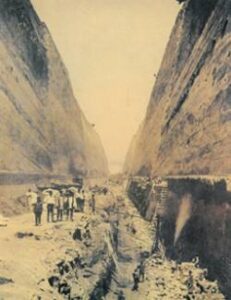The Countdown

In 1830 the first governor of Greece Ioannis Kapodistrias decided to carry on with the ambitious project. The plan of opening the Isthmus came to the fore again. Ioannis Kapodistrias entrusted the project to the French engineer Virle d’ Uct, who had estimated that approximately 40 million gold francs would be needed in order for the project to be completed. This amount was too big for the young Greek nation.
But it was too late. In 1869 the Suez Canal functioned and that process roused the Greek government to decide the intensification of their efforts. The same year the Zaimis Government decided and voted the law “on the Isthmus canalization” and essentially favourable decisions were taken for the establishment of companies in order to undertake the project.
Under this arrangement the government was entitled to give up the privilege of construction and exploitation of the Corinth Canal to a company or an individual. For this purpose they signed in 1870 a contract with French entrepreneurs. That Contract, however, weakened and in1882 the establishment of the “International Society of Marine Corinth Canal” became possible by the Hungarian General Istvan Turr, to whom the Greek government a year earlier had awarded the project with the privilege of its exploitation for 99 years.
The company was formed with the assistance of the French bank and its corporative fund which were consisted of 60,000 shares of 500 francs each. France with the canalization of the Isthmus of Corinth compounded with the largest speculative phase of the 19th century in Europe. The French constructional companies which were involved in the project have developed into powerful economic organizations and the projects began, based on Nero’s plans.
The commencement of the project was on April 23, 1882, in the presence of King George I and many guests of honour. It was one of the most important public projects that were conduced in the late 19th century and were linked to the face of the modernize Prime Minister Harilaos Trikoupis.
The study of the project was made by the Hungarian Bella Gerster, Chief Engineer of the Canal Francis in Hungary. For the materialization of it, architects and engineers from across Europe collaborated and original explosive equipment were used, dynamite and other explosive materials from the Nobel family factories both in Italy and Germany. However the project stopped again after approximately 8 years because of Tyrr’s bankruptcy and lack of money.
In 1890 the effort continued from the Greek contracting company and with the participation of benefactor Andreas Suggros. Eventually the canal was opened in 1893 after 11 years of works. On 25.7.1893 in the presence of the Kings and the Government, officiated by the eparch of Corinth the opening of the Corinth Canal was made. The opening of the Isthmus, one of the greatest achievements of the construction period, shortened the sea route from Piraeus to Italy by half.





